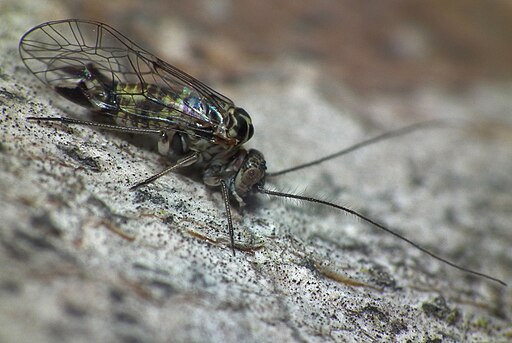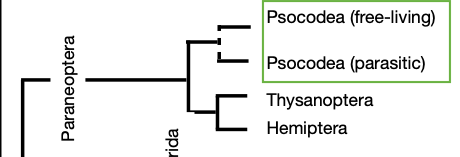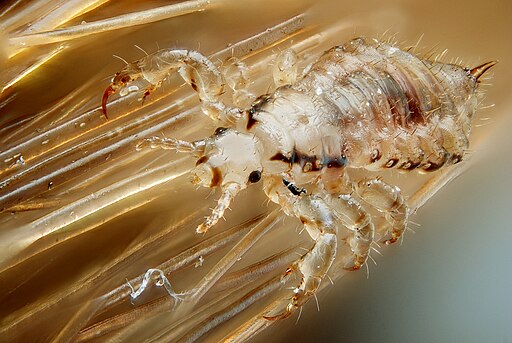28 Orders of Insects: Psocodea

Order Psocodea: Barklice, booklice, and body lice
Until recently barklice, booklice and parasitic lice were regarded as discrete, separate orders but now they are regarded as belonging to the same order, given the name Order Psocodea. Note that this classification is fairly recent so older editions of your text book might list them as discrete orders. Psocoptera (barklice & booklice) and Pthiraptera (parasitic lice) are currently classified as a ‘higher taxon’, not a suborder.
For additional information, go to this website and examine the relationships of barklice, booklice and parasitic lice.

Psocodea: Psocoptera (barklice, booklice) – higher taxon
Psocodea – Psocoptera
- common names: psocids, barklice, or booklice
- scientific name: Greek, psocus = rubbed or gnawed
- worldwide distribution, ~3000spp.; about 300 species in Australia.
- live in all major habitats; found in leaf litter, foliage, bark of trees; some species associated with human dwellings, natural habitat unknown
- food includes:
- lichens, algae, fungi, yeasts, dead insects (insect collections), pollen, exuvia
- domestic species frequently feed on starch: flour, book bindings, grains
- some are pests in insect collections, libraries & herbaria; some are grain pests
- some species are mymecophilous (live in ant colonies)
Characteristics of Psocodea-Psocoptera
Adults
- minute to small (1-10mm), stout, soft bodied
- head large and mobile, asymmetrical chewing mouthparts; large, compound eyes; ocelli present in winged species
- neck-like restriction between head and thorax; antennae long, slender, filiform
- wings reduced or absent (booklice); if wings present, membranous and with reduced venation; wings held roof-like over the abdomen (barklice)
- cerci absent
Immatures
- Immature stages (nymphs) resemble small adults

Psocodea: Phthiraptera (parasitic lice) – higher taxon
Psocodea – Phthiraptera
- common name: lice
- scientific name: Greek, ‘phthir’ = lice and ‘aptera’ = wingless
- appx. 5000 spp. worldwide; found throughout Australia with about 255 described spp.
- all are obligate ectoparasites of birds and mammals; entire life spent on host
- eggs (nits) usually cemented to feathers or hair of host
- some lice carry disease vectors to humans, notably epidemic typhus (ET)
- lice of marine mammals, e.g. elephant seals, usually burrow into thick skin
Characteristics of Phthiraptera
Adults
- small (<10mm), dorsoventrally flattened, colourless
- head conical in sucking lice; broad and flat in chewing lice; eyes absent or reduced; antennae short
- mandibulate, biting mouthparts (biting lice) or beaklike, piercing and sucking mouthparts (sucking lice)
- wingless; legs well developed and stout with strong claws; adapted for clinging to host
Immatures
- immature stages (nymphs) resemble adults but smaller
Three suborders in Australia:
- Amblycera – biting lice; feed on bird feathers and mammal skin; usually two small tarsal claws
- Ischnocera – biting lice; feed on bird feathers and mammal skin; usually two small tarsal claws
- Anoplura – sucking lice; feed solely on mammal blood (except bats); usually one large tarsal claw
For more details check out these pages from CSIRO: Psocoptera and Phthiraptera
Notes:
Some adaptations for clinging to host.
Morphological adaptations:
-
- flattened body
- strong legs and claws
- powerful mandibles
- numerous setae
Behavioural adaptations:
-
- negatively phototropic
- settle in places where they can avoid being dislodged by grooming
- most bite skin at base of hair or feathers for blood (and skin oils)
Some examples of Human Lice:
Crab louse: Phthirus pubis
-
- favored habitat is pubic area (also other body hair)
- not implicated in any disease transmission.
Body louse: Pediculus humanus
-
- scatters eggs unattached
- transmits epidemic typhus.
Head louse: Pediculus capitus
-
- glues eggs to hair
- no disease transmission
- increasingly common in school children.
Topic Review
Do you know…?
- the main anatomical features of Psocoptera
- the main anatomical features of Phthiraptera
- how lice are adapted to their lifestyle

